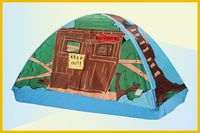Introduction
Sensory tents are becoming increasingly popular among families with children who have autism spectrum disorder (ASD) or other sensory processing issues. These tents are designed to create a safe and controlled environment that helps children manage their sensitivity to light, sound, and touch. In this article, we will explore the benefits of using a sensory tent for autism, how to make your own, and some of the best options available on the market.
What is a Sensory Tent?
A sensory tent is a small, indoor structure that is specifically designed to provide a calming and soothing environment for individuals with sensory processing issues. It is typically outfitted with soft lighting, calming scents, and various sensory items such as weighted blankets, fidget toys, and beanbags. The interior of the tent is equipped with a variety of items that are designed to stimulate the senses and promote relaxation.
Benefits of Using a Sensory Tent for Autism
Reduces Sensory Overload
For children with ASD, exposure to excessive light and sound can be overwhelming and distressing. A sensory tent creates a controlled environment that minimizes sensory input, allowing children to calm down and self-reflect in a safe and secure space.
Promotes Relaxation and Sleep
Many children with ASD have difficulty sleeping due to insomnia, hyperactivity, and other sleeping disorders. A sensory tent provides a quiet and dark environment that is conducive to relaxation and sleep. The use of calming lighting and soothing scents can help children fall asleep faster and stay asleep longer.
Helps with Self-Regulation
Sensory tents can be incredibly helpful in teaching children with ASD how to self-regulate their emotions and behaviors. Through exposure to sensory input and the use of calming activities, children can learn to identify feelings of excitement, frustration, and calming, and develop skills to manage their emotions in a more effective way.
How to Make Your Own Sensory Tent
Materials Needed
To make a basic sensory tent, you will need the following items:
-
Large piece of fabric (such as a sheet or blanket) to serve as the tent cover
-
Tent frame orPVC pipe structure to hold the fabric in place
-
Pillows, blankets, and soft lighting to create a calming atmosphere inside the tent
-
Sensory items such as fidget toys, weighted blankets, or calming scents
Step-by-Step Instructions
-
Choose a location where the tent will be set up.
-
Assemble the tent frame or PVC pipe structure according to the manufacturer's instructions.
-
Drape the large piece of fabric over the support structure and secure it in place.
-
Add pillows, blankets, and soft lighting to create a calming atmosphere inside the tent.
-
Incorporate sensory items such as fidget toys, weighted blankets, or calming scents to enhance the sensory experience.
-
personalise the tent to the individual's specific sensory needs and preferences.
##Sensory tents can be a valuable tool for improving the quality of life for children with ASD.通过在孩子的房间中添加一个感光帐篷,父母可以为孩子提供一个安全、可控的环境来应对难以控制的冲动和过度刺激的症状。
请注意,虽然许多感光帐篷专为自闭症儿童设计,但它们的基本模型也可以为其他孩子提供安慰和支持。重要的是,感光帐篷应该被视为一种可以支持儿童发展的工具,而不是治疗或干预手段。
最后,如果您决定在家中创建一个自闭症感光帐篷,您可能需要考虑一些额外事项,比如安装儿童家具以及选择适合您孩子喜好的颜色和材料。






